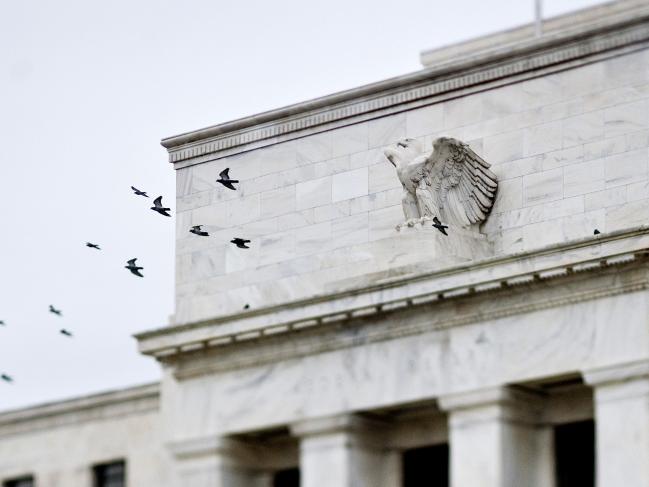(Bloomberg) -- The Federal Reserve has announced a raft of emergency lending programs, with approval from the Treasury Department, to help the U.S. economy weather the devastating impact of the coronavirus pandemic. These could ultimately deploy trillions of dollars in lending.
The programs seek to keep financial markets functioning and, in unprecedented steps, provide direct loans to businesses, states and local governments.
Here’s a round-up of the nine programs -- five of which are now up and running -- with details on their current status. Lending totals are as of May 6 and the Fed is due to report an update on those facilities in its weekly data later Thursday:
Commercial Paper Funding Facility (CPFF)
- Announced: March 17
- Launched: April 14
- Treasury backstop: $10 billion
- Program limit: none
- Deployed: $3.99 billion
Purchases short-term company IOUs directly from U.S. corporate and municipal issuers. Eligible securities about $1.1 trillion. Demand has been low as the Fed’s mere pledge to backstop the market drew normal lenders back in.
Primary Dealer Credit Facility (PDCF)
- Announced: March 17
- Launched: March 20
- Treasury backstop: none
- Program limit: none
- Deployed: $14.9 billion
Buys a wide range of securities, including investment-grade corporate debt, municipal debt, and mortgage- and asset-backed securities from primary dealers, which are the big banks and broker-dealers licensed to transact with the Fed. Its lending peaked in mid April at around $33 billion, then faded as the short-term funding markets calmed.
Money Market Fund Liquidity Facility (MMFLF)
- Announced: March 18
- Launched: March 23
- Treasury backstop: $10 billion
- Program limit: none
- Deployed: $42.8 billion
Finances the purchase of high-quality assets from U.S. money market mutual funds, including government debt, commercial paper and municipal debt. Eligible securities estimated at $600 billion to $700 billion, according to Fed officials. Lending peaked in early April at around $53 billion as withdrawals from prime money funds halted and then reversed.
Primary Market Corporate Credit Facility (PMCCF)
- Announced: March 23
- Not yet operational
- Treasury backstop: $50 billion
- Program limit: $500 billion
Will buy investment-grade corporate debt with maturities up to four years directly from U.S. issuers, and debt from some issuers downgraded after March 22.
Secondary Market Corporate Credit Facility (SMCCF)
- Announced: March 23
- Launched: May 12
- Treasury backstop: $25 billion
- Program limit: $250 billion
Purchase investment-grade corporate debt from U.S. issuers with maturities up to five years in the secondary market, debt from some issuers downgraded after March 22 and some ETFs that buy corporate debt. The New York Fed began ETF purchases on May 12.
Term Asset-Backed Securities Loan Facility (TALF)
- Announced: March 23
- Not yet operational
- Treasury backstop: $10 billion
- Program limit: $100 billion
Will purchase securities backed by credits to consumers and small businesses, including credit-card receivables, student loans, auto loans and leases, equipment loans and some small business loans.
Paycheck Protection Program Liquidity Facility (PPPLF)
- Announced: April 6
- Launched: April 16
- Treasury backstop: none
- Program limit: none
- Deployed: $29.2 billion
Finances lending to small businesses that qualify for the Treasury’s Paycheck Protection Program. Congress appropriated a total of $669 billion for the loans, which can turn into grants if companies retain or hire back workers.
Municipal Liquidity Facility (MLF)
- Announced: April 9
- Not yet operational
- Treasury backstop: $35 billion
- Program limit: $500 billion
Will purchase municipal debt maturing in less than 36 months directly from states, counties and cities. After initial criticism, the Fed lowered the population thresholds for eligible counties and cities to 500,000 and 250,000, respectively. Issuers must have held an investment-grade rating as of April 8.
Main Street Lending Program
- Announced: April 9
- Not yet operational
- Treasury backstop: $75 billion
- Program limit: $600 billion
Will finance full recourse bank lending to U.S. companies with fewer than 15,000 employees or less than $5 billion in annual revenue. The four-year loans will be extended through three distinct facilities: one for new loans, another for increasing existing debt and a third for more heavily leveraged borrowers.
- New Loan Facility: Maximum loan size of $25 million or four times 2019 adjusted EBITDA. Lenders retain a 5% stake in each loan. Minimum loan size is $500,000.
- Expanded Loan Facility: Maximum loan size $200 million, 35% of a borrower’s outstanding debt or six times 2019 adjusted EBITDA. Lenders retain a 5% stake. Minimum loan size is $10 million.
- Priority Loan Facility: Maximum loan size of $25 million or six times 2019 adjusted EBITDA. Lenders retain 15% stake. Minimum loan size is $500,000.
©2020 Bloomberg L.P.
